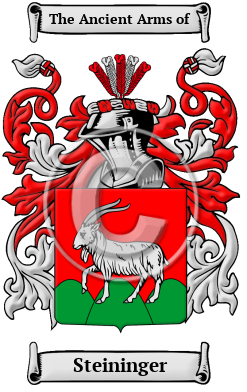| ![Show Contents]() Steininger History, Family Crest & Coats of Arms Steininger History, Family Crest & Coats of Arms
- Origins Available:
Germany
Etymology of SteiningerWhat does the name Steininger mean? The long and noble heritage behind the name of Steininger first began in medieval Austria. While the patronymic and metronymic surnames, which are derived from the name of the father and mother respectively, are the most common form of a hereditary surname in Germany, occupational surnames also emerged during the late Middle Ages. Many people, such as the Steininger family, adopted the name of their occupation as their surname. However, an occupational name did not become a hereditary surname until the office or type of employment became hereditary. The surname Steininger literally means "stone" 1 and was an occupational name for a stone cutter. Further research revealed that the name is derived from the Old German word stein, meaning stone. In some cases the name may be topographical in nature and derive from the fact the original bearer lived near a prominent stone or rock. Early Origins of the Steininger familyThe surname Steininger was first found in Austria, in the cities of Berne and Neuchatel, where the name was anciently associated with the tribal conflicts of the area. They declared allegiances to many nobles and princes of early history, lending their influence in regional political struggles for power. They branched into many houses in Austria, and their contributions were sought by many leaders in their search for power. Early History of the Steininger familyThis web page shows only a small excerpt of our Steininger research. Another 128 words (9 lines of text) covering the years 1796, 1809, 1810, 1820, 1838, 1863 and 1935 are included under the topic Early Steininger History in all our PDF Extended History products and printed products wherever possible. Steininger Spelling VariationsOne can encounter great variation in the spelling of surnames: in early times, spelling in general, and thus the spelling of names was not yet standardized; and later, spellings would change with branching and movement of families. Variations of the name Steininger include Steiner, Steinert, Steinertz, Steinerth, Steinere, Stein, Steine and many more. Early Notables of the Steininger familyAnother 43 words (3 lines of text) are included under the topic Early Steininger Notables in all our PDF Extended History products and printed products wherever possible.
| Steininger migration to the United States | + |
After the First World War, Austria became a republic. The Treaty of Versailles broke up the empire in 1919 and many of the Sudeten Germans were incorporated into the new nation of Czechoslovakia. In the 20th century, many Austrians migrated to other parts of Germany or Europe, as well as to North America. In the United States, the majority of settlers landed in Philadelphia, and moved on to Ohio, Texas, Illinois, California, New York, and Maryland. Many German settlers also migrated to Canada, particularly Ontario and the Prairies. Amongst the settlers in North America with this distinguished name Steininger were
Steininger Settlers in United States in the 18th Century- Johan Leonard Steininger, aged 35, who landed in Pennsylvania in 1731 2
- Leonard Steininger, who landed in Pennsylvania in 1731 2
- Magdalena Steininger, aged 30, who arrived in Pennsylvania in 1735 2
Steininger Settlers in United States in the 19th Century- John M Steininger, who arrived in St Clair County, Illinois in 1864 2
| Contemporary Notables of the name Steininger (post 1700) | + |
- Rolf Steininger (b. 1942), German historian and university professor of contemporary history
- Michel Steininger (b. 1935), Swiss Olympic fencer
- Bahlow, Hans, Dictionary of German Names. translated by Edda Gentry, Wisconsin: The Board of Regents of the University of Wisconsin System, 2002. Print. (ISBN 0-924119-35-7)
- Filby, P. William, Meyer, Mary K., Passenger and immigration lists index : a guide to published arrival records of about 500,000 passengers who came to the United States and Canada in the seventeenth, eighteenth, and nineteenth centuries. 1982-1985 Cumulated Supplements in Four Volumes Detroit, Mich. : Gale Research Co., 1985, Print (ISBN 0-8103-1795-8)
 |

